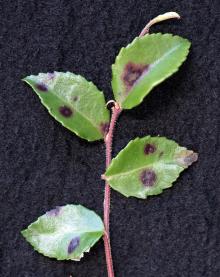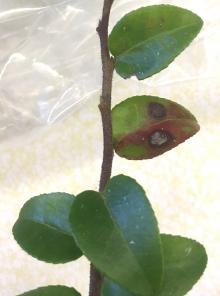See:
Cranberry (Vaccinium macrocarpon) - Botryosphaeria Fruit Rot and Berry Speckle
Cause Leaf spots are not very common but a few have been reported on evergreen huckleberry including Coleophoma empetri (from WA), Lophodermium maculare (from OR), and Phyllosticta vaccinii (from OR). Tar spot, Rhytisma vaccinii, has also been reported from WA.
Symptoms Phyllosticta vaccinii - Necrotic, circular leaf spots with a gray centers and brown to dark-purple boarder. Small black fruiting bodies (pycnidia) may be seen in the central area. Some leaf reddening occurs on affected leave but not all.
Cultural control
- Space plants for good air circulation and to promote drying under wet conditions.
- Remove infected, dead, and dying leaves on, under and near plants.
Chemical control No chemicals are specifically registered for this disease on huckleberry; however, the following may be effective.
- Proline 480 SC at 5.7 fl oz/A. Do not use within 7 days of harvest. Group 3 fungicide. 12-hr reentry.
- Propulse at 13.6 fl oz/A. Do not use within 7 days of harvest. Group 3 + 7 fungicide. 12-hr reentry.
- Quadris at 6 to 15.5 fl oz/A. Do not apply with silicone-based surfactants. May be applied on the day of harvest. Group 11 fungicide. 4-hr reentry.
- Quadris Top at 12 to 14 fl oz/A. Do not use within 7 days of harvest or mix with insecticides due to bee toxicity. Group 3 + 11 fungicide. 12-hr reentry.
- QuiltXcel at 14 to 21 fl oz/A. Do not use within 30 days of harvest. Sprayers should not be used on apples. Group 3 + 11 fungicide. 12-hr reentry.
- Tilt at 6 fl oz/A. Do not use within 30 days of harvest. 24-hr reentry.
Reference Bonar, L. 1928. Studies on some California fungi. Mycologia 20:292-300.




